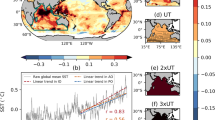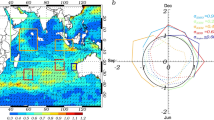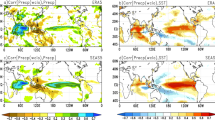Abstract
In this study we examine the impact of Indian Ocean sea surface temperature (SST) variability on South American circulation using observations and a suite of numerical experiments forced by a combination of Indian and Pacific SST anomalies. Previous studies have shown that the Indian Ocean Dipole (IOD) mode can affect climate over remote regions across the globe, including over South America. Here we show that such a link exists not only with the IOD, but also with the Indian Ocean basin-wide warming (IOBW). The IOBW, a response to El Niño events, tends to reinforce the South American anomalous circulation in March-to-May associated with the warm events in the Pacific. This leads to increased rainfall in the La Plata basin and decreased rainfall over the northern regions of the continent. In addition, the IOBW is suggested to be an important factor for modulating the persistence of dry conditions over northeastern South America during austral autumn. The link between the IOBW and South American climate occurs via alterations of the Walker circulation pattern and through a mid-latitude wave-train teleconnection.















Similar content being viewed by others
References
Aceituno P (1988) On the functioning of the Southern oscillation in the South America sector part I: surface climate. Mon Wea Rev 116:505–524
Ambrizzi T, Souza EB, Pulwarty RS (2004) The Hadley and Walker regional circulations and associated ENSO impacts on the South American seasonal rainfall. In: Diaz HF, Bradley RS (eds) The Hadley circulation: present, past and future. Kluwer, Dordrecht, pp 203–238
Annamalai H, Xie S-P, McCreary JP, Murtugudde R (2005) Impact of Indian Ocean sea surface temperature on developing El Niño. J Clim 18:302–319
Ashok K, Guan Z, Yamagata T (2001) Impact of the Indian Ocean dipole on the relationship between the Indian monsoon rainfall and ENSO. Geophys Res Lett 28(23):4499–4502
Baquero-Bernal A, Latif M, Legutke S (2002) On dipolelike variability of sea surface temperature in the tropical Indian Ocean. J Clim 15:1358–1368
Beck C, Grieser J, Rudolf B (2005) A new monthly precipitation climatology for the global land areas for the period 1951 to 2000. DWD, Klimastatusbericht KSB 2004, pp 181–190
Behera S, Luo J, Masson S, Rao S, Sakuma H (2006) A CGCM study on the interaction between IOD and ENSO. J Clim 19:1688–1705
Cai W, Cowan T, Raupach M (2009) Positive Indian Ocean dipole events precondition southeast Australia bushfires. Geophys Res Lett 36:L19710. doi:10.1029/2009GL039902
Chambers DP, Tapley BD, Stewart RH (1999) Anomalous warming in the Indian Ocean coincident with El Niño. J Geophys Res 104:3035–3047
Chan S, Behera S, Yamagata T (2008) Indian Ocean dipole influence on South American rainfall. Geophys Res Lett 35(14):L14S12
Clark CO, Webster PJ, Cole J (2003) Interdecadal variability of the relationship between the Indian Ocean zonal mode and East African coastal rainfall anomalies. J Clim 16(3):548–554
Coelho CAS, Uvo CB, Ambrizzi T (2002) Exploring the impacts of the tropical Pacific SST on the precipitation patterns over South America during ENSO periods. Theor Appl Climatol 71:185–197
Collins WD et al (2004) Description of the NCAR community atmosphere model (CAM 3.0). National Center for Atmospheric Research Rep. NCAR/TN-464 1 STR, p 226
Drumond AR de M, Ambrizzi T (2008) The role of the South Indian and Pacific oceans in South American monsoon variability. Theor Appl Climatol 94:125–137
Diaz AF, Studzinski CD, Mechoso CR (1998) Relationships between precipitation anomalies in Uruguay and Southern Brazil and sea surface temperature in Pacific and Atlantic Oceans. J Clim 11:251–271
Dommenget D, Latif M (2002) A cautionary note on the interpretation of EOFs. J Clim 15:216–225
Fischer A, Terray P, Delecluse P, Gualdi S, Guilyardi E (2005) Two independent triggers for the Indian Ocean dipole/zonal mode in a coupled GCM. J Clim 18:3428–3449
Gill AE (1980) Some simple solutions for heat-induced tropical circulation. Quart J Roy Meteor Soc 106:447–462
Grimm AM (2003) The El Niño impact on the summer monsoon in Brazil: regional processes versus remote influences. J Clim 16:263–280
Grimm AM, Ferraz SET, Gomes J (1998) Precipitation anomalies in Southern Brazil associated with El Niño and La Niña events. J Clim 11:2863–2880
Grimm AM, Barros VR, Doyle ME (2000) Climate variability in Southern South America associated with El Niño and La Niña events. J Clim 1:35–58
Herdies DL, da Silva A, Silva Dias MAF, Nieto-Ferreira R (2002) Moisture budget of the bimodal pattern of the summer circulation over South America. J Geophys Res 107:8075–8088
Kalnay E et al (1996) The NCEP/NCAR 40-years reanalysis project. Bull Am Meteor Soc 77:437–471
Karoly DJ (1989) Southern Hemisphere circulation features associated with El-Niño Southern Oscillation. J Clim 2:1239–1252
Klein SA, Soden B, Lau N-C (1999) Remote sea surface temperature variations during ENSO: evidence for a tropical atmospheric bridge. J Clim 12:917–932
Lau N-C, Nath MJ (2003) Atmosphere-Ocean variations in the Indo-Pacific sector during ENSO episodes. J Clim 16:3–20
Lee S-K, Wang C, Mapes BE (2009) A simple atmospheric model of the local and teleconnection responses to tropical heating anomalies. J Clim 22(2):272–284
Matsuno T (1966) Quasi-geostrophic motions in the equatorial area. J Meteor Soc Jpn 44:25–43
Pezzi LP, Cavalcanti IFA (2001) The relative importance of ENSO and tropical Atlantic sea surface temperature anomalies for seasonal precipitation over South America: a numerical study. Clim Dyn 17:205–212
Rayner NA, Parker DE, Horton EB, Folland CK, Alexander LV, Rowell DP, Kent EC, Kaplan A (2003) Global analyses of sea surface temperature, sea ice, and night marine air temperature since the late nineteenth century. J Geophys Res 108(D14):4407. doi:10.1029/2002JD002670
Ropelewski CF, Halpert MS (1989) Precipitation patterns associated with the high index phase of the Southern Oscillation. J Clim 2:268–284
Rudolf B, Hauschild H, Rueth W, Schneider U (1994) Terrestrial precipitation analysis: operational method and required density of point measurements. In: Desbois M, Desalmond F (eds) Global precipitations and climate change, NATO ASI series I, vol 26. Springer, Berlin, pp 173–186
Saji NH, Goswami BN, Vinayachandran PN, Yamagata T (1999) A dipole mode in the tropical Indian Ocean. Nature 401:360–363
Saji NH, Ambrizzi T, Ferraz SET (2005) Indian Ocean dipole mode events and austral surface temperature anomalies. Dyn Atmos Oceans 39:87–102
Schott FA, Xie S, McCreary JP (2009) Indian Ocean circulation and climate variability. Rev Geophys 47:RG1002
Silva GAM, Ambrizzi T (2009) Summertime moisture transport over Southeastern South America and extratropical cyclones behavior during inter-El Niño events. Theor Appl Climatol 101:303–310
Souza EB, Ambrizzi T (2002) ENSO impacts on the South American rainfall during 1980s: Hadley and Walker circulation. Atmósfera 15:105–120
Spencer H (2004) Role of the atmosphere in seasonal phase locking of El Niño. Geophys Res Lett 31(24):L24104
Taschetto AS, Wainer I (2008) The impact of the subtropical South Atlantic SST on South American precipitation. Ann Geophys 26(11):3457–3476
Taschetto AS, Sen Gupta A, Hendon HH, Ummenhofer CC, England MH (2011) The relative contribution of Indian Ocean sea surface temperature anomalies on Australian summer rainfall during El Niño events. J Clim 24:3734–3747
Ummenhofer CC, Sen Gupta A, England MH, Reason C (2009a) Contributions of Indian Ocean Sea surface temperatures to enhanced East African rainfall. J Clim 22(4):993–1013
Ummenhofer CC, England MH, McIntosh PC, Meyers GA, Pook MJ, Risbey JS, Sen Gupta A, Taschetto AS (2009b) What causes southeast Australia’s worst droughts? Geophys Res Lett 36:L04706. doi:10.1029/2008GL036801
Uvo CRB, Repelli CA, Zebiak SE, Kushnir Y (1998) The relationships between tropical Pacific and Atlantic SST and northeast Brazil monthly precipitation. J Clim 11:551–562
Xie S-P, Hu K, Hafner J, Tokinaga H, Du Y, Huang G, Sampe T (2009) Indian Ocean capacitor effect on Indo–Western Pacific climate during the summer following El Niño. J Clim 22:730–747
Yang J, Liu Q, Liu Z, Wu L, Huang F (2009) Basin mode of Indian Ocean sea surface temperature and Northern Hemisphere circumglobal teleconnection. Geophys Res Lett 36:L19705
Yu J-Y, Mechoso CR (1999) A discussion on the errors in the surface heat fluxes simulated by a coupled GCM. J Clim 12:416–426
Zhou T, Yu R, Li H, Wang B (2008) Ocean forcing to changes in global monsoon precipitation over the recent half-century. J Clim 21:3833–3852
Acknowledgments
The authors are grateful to Dr. Laura Ciasto for her help in editing the manuscript. GPCC Precipitation data provided by the NOAA/OAR/ESRL PSD, Boulder, Colorado, USA, from their Web site at http://www.esrl.noaa.gov/psd/. The HadISST1 is available at the UK Meteorological Office, http://www.badc.nerc.ac.uk/data/hadisst/. Use of NCAR CAM3 model is gratefully acknowledged. The model simulations were run at the Australian Partnership for Advanced Computing National Facility. This research was supported by the Australian Research Council and the State of São Paulo Research Foundation (FAPESP). T. Ambrizzi has also received funding from CNPq (Brazilian National Council for Scientific and Technologic Development), and from the European Community’s Seventh Framework Programme (FP7/2007–2013) under Grant Agreement No. 212492 (CLARIS LPB-A Europe-South America Network for Climate Change Assessment and Impact Studies in La Plata Basin).
Author information
Authors and Affiliations
Corresponding author
Rights and permissions
About this article
Cite this article
Taschetto, A.S., Ambrizzi, T. Can Indian Ocean SST anomalies influence South American rainfall?. Clim Dyn 38, 1615–1628 (2012). https://doi.org/10.1007/s00382-011-1165-3
Received:
Accepted:
Published:
Issue Date:
DOI: https://doi.org/10.1007/s00382-011-1165-3




